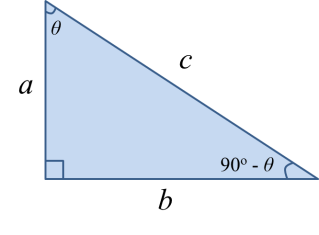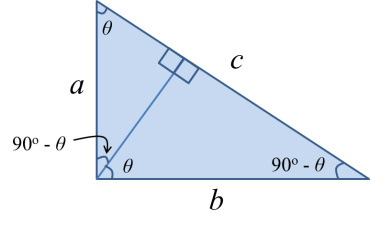| This is the original equation. | ax2 + bx + c = 0 |
| Move the loose number to the other side. | ax2 + bx = –c |
| Divide through by whatever is multiplied on the squared term. Take half of the x-term, and square it.Add the squared term to both sides. |  |
| Simplify on the right-hand side; in this case, simplify by converting to a common denominator. | |
| Convert the left-hand side to square form (and do a bit more simplifying on the right). | |
| Square-root both sides, remembering to put the "±" on the right. | |
| Solve for "x =", and simplify as necessary. |
Derivation of law of sine:
We want to show that 


To do this, let us draw a triangle. Examining the three interior angles, we shall use the fact that the area is equal in all three cases to prove the above identity.
In the following diagram, angles are labeled with capital letters and sides with lowercase letters.

Now, let’s draw a line from angle C down to the line AB. That will be one of the heights of the triangle. This creates a right triangle. (It is labeled red in the next diagram.)

Recall that the area of a triangle is 











Looking at angle B instead of angle A, we see that 








Let us draw another height in the triangle so that we can use angle C to find the area of the triangle. Again, we have created a right triangle.

Notice that 








We know that the areas have to be equal, so setting the three equations equal we get the following:
Rewriting, and multiplying by 2, we get:
Now, let’s divide by abc. We can do this since none of the sides equal to 0. (If any side was 0 then we wouldn’t have a triangle.) Doing this, we get:
source: http://math.ucsd.edu/~wgarner/math4c/derivations/trigidentities/lawofsines.htm
Derivations of law of cosine:
The best way to approach this is to draw a picture. We shall draw two pictures, one for each possibility: (i) the angle (angle C) is acute or (ii) the angle is obtuse. Regardless, the calculations are the same.
(i) (ii)


In both pictures, one vertex (angle C) is at the origin, the vertex of angle A is at (b,0), and the vertex of angle B is at (acos C, asin C).
To justify this, think of point B lying on a circle with radius a. The x-coordinate is expressed as the radius times the cosine of the angle while the y-coordinate is expressed as the radius times the sine of the angle.
Now, let’s use the distance formula to find the length of c2. The distance formula is
So, using the above information, we get the following:


And so, we have shown one case. We could repeat the above steps for a2 and for b2, by drawing similar triangle, but the above diagram suffices. (Just label angles differently.) Therefore, we are done.
Note that the placement of the triangle simplified the calculations, but the triangle could be positioned anywhere. Since the placement was arbitrary, our results are true, even though we put it at origin as was described above.
souce: http://math.ucsd.edu/~wgarner/math4c/derivations/trigidentities/lawofcosines.htm
Derivation of Pythagorean theorem:
Sometimes I am amazed by the permanence of mathematical discovery. Math, it seems to me, is quite unique among the creative intellectual pursuits (science, art, engineering) for the seemingly unlimited lifetime of its innovations.
For example, Aristotle was a brilliant natural philosopher, as much a genius as just about any modern scientist, and he advanced (what would become) physics tremendously during the 4th century BC. But by now his theory of the five elements is completely unnecessary for anyone to learn. While it produced an important advancement in our thinking, it has been replaced by more correct physical theories. Thus, Aristotle suffered that same fate that meets seemingly every scientist or inventor eventually: further discoveries made him obsolete.
Pythagoras, on the other hand, who lived roughly 200 years before Aristotle, is someone whose major contribution to mathematics is still used every day. I literally could not do my job without the Pythagorean theorem, and neither could just about any scientist or engineer. Unlike nearly all other kinds of innovations, it has very much not been replaced.
After 2,500 years,  is still equal to
is still equal to  .
.
What’s important to notice is not just that Pythagoras’s result is still important, but that the type of reasoning that leads to his result is still important. Put simply, a good scientist or engineer needs to be capable of understanding and reproducing a derivation of the 2500-year-old Pythagorean theorem, not just because the theorem is important, but because that level of logical thinking is necessary for his/her job.
So in this post I think it’s worth sharing my own favorite derivation of the Pythagorean theorem. This derivation is the simplest one I know of, and it doesn’t require any tremendous geometric cleverness (like a tangram puzzle) or complicated diagrams. Instead, it relies only on a very basic use of scaling arguments.
Scaling arguments are among the simplest and most powerful tools in theoretical physics. They allow you to reach remarkably concrete conclusions about a problem even when you don’t know essentially any details about the system in question. The key idea is to imagine scaling the system up or down in size, and then saying something about how it should change as you do so.
For example, suppose you don’t know anything about triangles except that they have an area. Since area is measured in units of length squared, you can immediately say that if you take some triangle and make its length  times bigger, than its area must get
times bigger, than its area must get  times larger.
times larger.
then the triangle below, which is the same as the previous one only magnified two times, must have an area  .
.
Meanwhile, all the side lengths of the bigger triangle are exactly two times longer than for the smaller one.
What all this means is that, for a given triangle, the area is proportional to the square of any one of its side lengths. I know this because as I make the triangle  times bigger, the side lengths all get
times bigger, the side lengths all get  times longer, and the area gets
times longer, and the area gets  times bigger. So if I want I can write
times bigger. So if I want I can write
The “something” in that equation depends on the angles in the triangle, but for now let’s assume that I am more or less completely ignorant about triangles and I can’t tell you what it is. Luckily enough for ignorant me, it turns out I don’t need to know what the “something” is in order to prove the Pythagorean theorem.
The key trick is to divide the large triangle into two smaller and completely equivalent triangles. That is, take this triangle:
and draw one line (an altitude through the right angle) so that it gets divided into two smaller triangles, like this:
You can tell that the two newly-created triangles are just scaled-down versions of the original one, because they have all the same angles. This means that the original triangle can be written as the sum of two smaller but otherwise completely identical triangles. Like this:
Finally, to prove the Pythagorean theorem, we just have to invoke the one equation in this post,  for each triangle. This gives:
for each triangle. This gives:
Since all the triangles are the same, all the “something”s are also the same, which means
Not bad, eh?
I don’t know whether you found the above proof “aesthetic,” but I certainly did. And it’s a pretty nice feeling to think that an insight had by someone more than 2,500 years ago can still feel beautiful to someone like me. And even more remarkably, that my life (and professional career) continue to profit from it.
source: http://gravityandlevity.wordpress.com/2013/05/08/the-simplest-derivation-of-the-pythagorean-theorem/
source: http://gravityandlevity.wordpress.com/2013/05/08/the-simplest-derivation-of-the-pythagorean-theorem/




